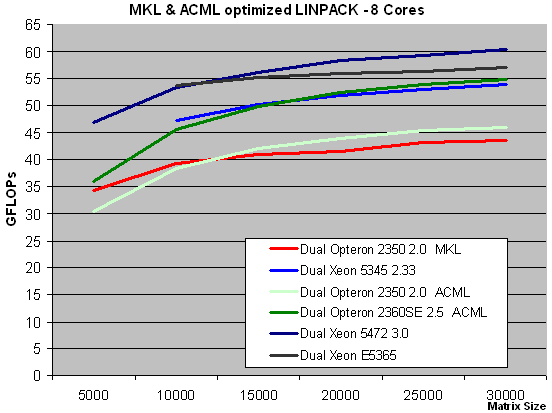AMD's 3rd generation Opteron versus Intel's 45nm Xeon: a closer look
by Johan De Gelas on November 27, 2007 6:00 AM EST- Posted in
- IT Computing
Floating-point Analyses (Linux 64-bit)
AMD's newest quad-core behaves pretty weird when it comes to floating-point applications. In some FP intensive applications (CINEBENCH and LINPACK for example) a 2GHz quad-core cannot even keep up with Intel's older 2GHz 65nm quad-core CPUs; in other applications it is a close match (3ds Max, POV-Ray); finally, in applications like zVisuel's 3D Engine and SPECfp, Barcelona is clearly faster clock-for-clock than the older generation. Our aim is to understand this situation a little better and to see what the 45nm Xeon 54xx can achieve.
To understand this we first tested with two synthetic, but completely opposite FP benchmarks:
- LINPACK,
which calculates on massive matrices
- FLOPS, which fits in an 8 KB L1 cache
Let us start with LINPACK. LINPACK, a benchmark application based on the LINPACK TPP code, has become the industry standard benchmark for HPC. It solves large systems of linear equations by using a high performance matrix kernel.
We used a workload of square matrices of sizes 5000 to 30000 by steps of 5000, and we ran four (dual dual-core) or eight (dual quad-core) threads. As the system was equipped with 8GB of RAM, the large matrixes all ran in memory. LINPACK is expressed in GFLOPS (Giga/Billions of Floating Operations Per Second).
We used two versions of LINPACK:
- Intel's
version of LINPACK compiled with the Intel Math Kernel Library (MKL)
- A fully optimized "K10-only" version for AMD's quad-core
The "K10-only" version uses the ACML version 4.0.0, compiled using the PGI 7.0.7. We used the following flags:
pgcc -O3 -fast -tp=barcelona-64

The graph above may come as a surprise to a quite few people. At the lower matrix sizes, AMD's quad-core is even a bit faster with the "Intel version" than with the specially optimized version. Only while calculating with the larger matrices does the heavily tuned version pull ahead. The K10-only version of LINPACK is about 6% faster, and the most important reason for that improvement is the ACML library of AMD. However, it is clear that the Intel MKL and compiler are not slowing the AMD core down when it is running LINPACK.
There is more. At first sight, the AMD 2360SE scores seem rather poor: just a tiny bit faster than the 2.33GHz quad-core of Intel. However, the Intel CPU scales rather poorly with clock speed: a 3GHz Clovertown is only 6% faster than a 2.33GHz one while the clock speed advantage is 28%. The Barcelona core however scales 19% from a 20% clock speed boost. The new Seaburg platform cannot help here: a 3GHz Xeon E5365 was capable of 57.1 GFLOPS, while it got 57 GFLOPS with the older chipset.
Intel's clever compiler engineers have already found a way around this, as the newest release of their LINPACK version is quite a bit faster on both Clovertown and Harpertown. The LINPACK score increases to 70 GLOPs for the Xeon 5472 3GHz (60.5 in our test) and 63 for the Xeon E5365 3GHz (57 in our test). Unfortunately, we don't have any data on what has changed, so we decided to freeze our benchmark code for now.










43 Comments
View All Comments
aeternitas - Thursday, December 13, 2007 - link
Then why are you here? Details is what technology is about!I for one have a pet peeve with tech sites that use the wrong formats in their stories. Slightly damages credibility. Not to say this is a big deal in this case, though .gif is pretty much dead, unless you use an old browser on old tech, but then why would you be reading this story?
Look on the bright side, at least this isnt a Codec vs. Codec story, where the author uses jpgs for such color-limited screenshots.
SonicIce - Tuesday, November 27, 2007 - link
I think the color depth was decreased alot more than 8 bit. That image only has 33 unique colors in it. Something went wrong with the dithering maybe? 256 is usually more than enough.Justin Case - Friday, November 30, 2007 - link
Who cares? The only part that suffers is the gradient at the top, all the relevant information is there, and this file is about half the size of what a PNG would be.